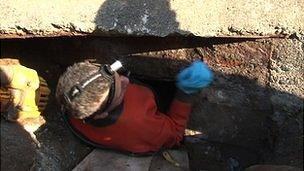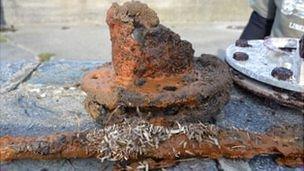Flooded WWII German bunker reopened by Festung Guernsey
- Published
A German bunker which had remained closed since World War II has been opened by a Guernsey historical group.
Festung Guernsey pumped the water out of the concrete structure at Vazon Bay, which was built to house a 4.7cm gun, before installing lights inside.
It was among the equipment left from the occupation of the island by German forces from June 1940 to May 1945.
Paul Bourgaize, from the group, said the finds would be put on display.
He said: "We have an identical bunker to this at L'Eree that we're hoping to use for tours, it's open now but come the summer we'll be getting a lot of visitors and the aim is to try to equip it with as many original items as possible.

The structure was cleared of water before the group could gain access through part of the old doorway
"There's quite a lot of ventilation pipe work, which for us is invaluable.
"There's some other items that have fallen off the walls over the course of time that have been laying in the seawater which at the moment don't look too pretty - hopefully they'll be restorable.
"The most surprising thing we found was a conger eel. He went back in the sea after we managed to catch him. We're still unsure as to how long he's been in there and how he got in."
Mr Bourgaize said they had chosen the bunker as it had been sealed since the war.
He said: "Probably people have been in the meantime, but we know that since shortly after the war it's been flooded to a depth of about 4ft, which normally puts people off."
The bunker was part of Hitler's Atlantikwall (Atlantic Wall), which was an extensive system of coastal fortifications built to defend mainland Europe from an Allied invasion.
The structures ran from northern Norway to France's border with Spain.

Mr Bourgaize said salvageable items would be used to refit a bunker the group had opened to visitors
Mr Bourgaize said of Vazon Bay: "It's the best obvious landing bay so obviously the Germans were mindful of that, they know an invading force has got to pick a good beach.
"When you look at the defences around the island, when you look at the south coast they are thinner and you come to the west coast and there's an awful lot - this whole area is not the place to be if you're attacking at all."
He said of Festung Guernsey's work to restore a bunker: "It is an important phase in our history, a very interesting military history what with the French and all those other things so this is just one small chunk of it.
"These bunkers have been sort of neglected and cast to one side really as people have just wanted to forget about [the war], which is understandable for those who were here during the occupation.
"As an historical society all we want to do is conserve a selection of them and make them available for people who are interested in looking at them."
- Published7 February 2012
- Published18 January 2012
- Published10 March 2011
- Published18 November 2010